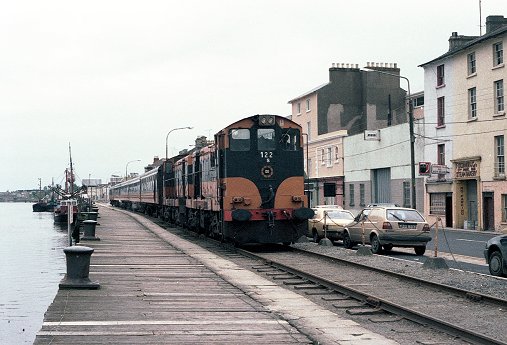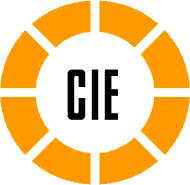Jernbane
|
Irske Jernbaner |
|
|
|
Stemningsbillede fra Rosslare - august 1985 - Kai W. Mosgaard © |
|
The history of rail transport in Ireland began only a decade later than in Great Britain. By its peak in 1920, Ireland had 5,500 route kilometers. The current status is less than half that amount, with a large unserviced area around the border area between Northern Ireland and the Republic of Ireland. Ireland's railways are run by Iarnród Éireann in the Republic and Northern Ireland Railways. The Railway Preservation Society of Ireland based in Whitehead, County Antrim runs preserved steam trains on the main line, with the Irish Traction Group preserving diesel locomotives, and operating on the main line. The Downpatrick & County Down Railway is the only self-contained full-size heritage railway in Ireland. Córas Iompair Éireann was originally established to provide road and railway transport, and later water. For most of its existence the company made large year-on-year losses, particularly the railways division, and this caused the public and politicians to demand "make CIÉ pay". Thus, similar to the pattern in many countries, Ireland's railways were rationalised and faced severe cutbacks while the road division was expanded. Córas Iompair Éireann was formed, as a private company, by the Transport Act 1944 and incorporated the Great Southern Railways Company and Dublin United Transport Company. At this point CIÉ adopted the logo of the latter company, "the flying snail". Great Southern Railways was incorporated in 1925, having been Great Southern Railway since 1924. It was essentially a monopoly on transport as it started to broaden its business interests into road transport. The Transport Act 1950 amalgamated CIÉ and the Grand Canal Company and formally nationalised CIÉ, changing its structure from a private limited company to a board appointed by the Minister for Transport. The Northern Ireland Great Northern Railway Act, 1958 transferred the lines of Great Northern Railway Board south of the border to CIÉ. Until 1986, CIÉ operated as a single legal entity, although it was internally organised into rail services, and two bus divisions - Dublin City Services and Provincial Services. The vast majority of services were simply branded CIÉ, although long distance provincial buses were branded "Expressway" while the Dublin electric railway service was branded DART. In 1987 CIÉ was reorganised into a holding company and three operating companies. In 1990 it sold its nine Great Southern Hotels to Aer Rianta, the airports authority, including the hotel in Derry, Northern Ireland. Current government policy is that Córas Iompair Éireann should be abolished with the three individual companies focusing on their own business areas and thus increasing competitiveness.[2] Despite this, legislation to enact this change has been frequently delayed, and has yet to be published as of 2008. In the meantime, the biggest change to CIÉ's operational structure since 1987 will come into being with the establishment of the Dublin Transport Authority, which will have powers over CIÉ's operations in the Greater Dublin Area. The Dublin Transport Authority Act 2008 also gives the Minister for Transport the power to appoint the directors of the subsidary companies instead of the chairman of CIÉ. (kilde: Wikipedia) |
|
|
||
|
|
|
|
|
|
|
|


